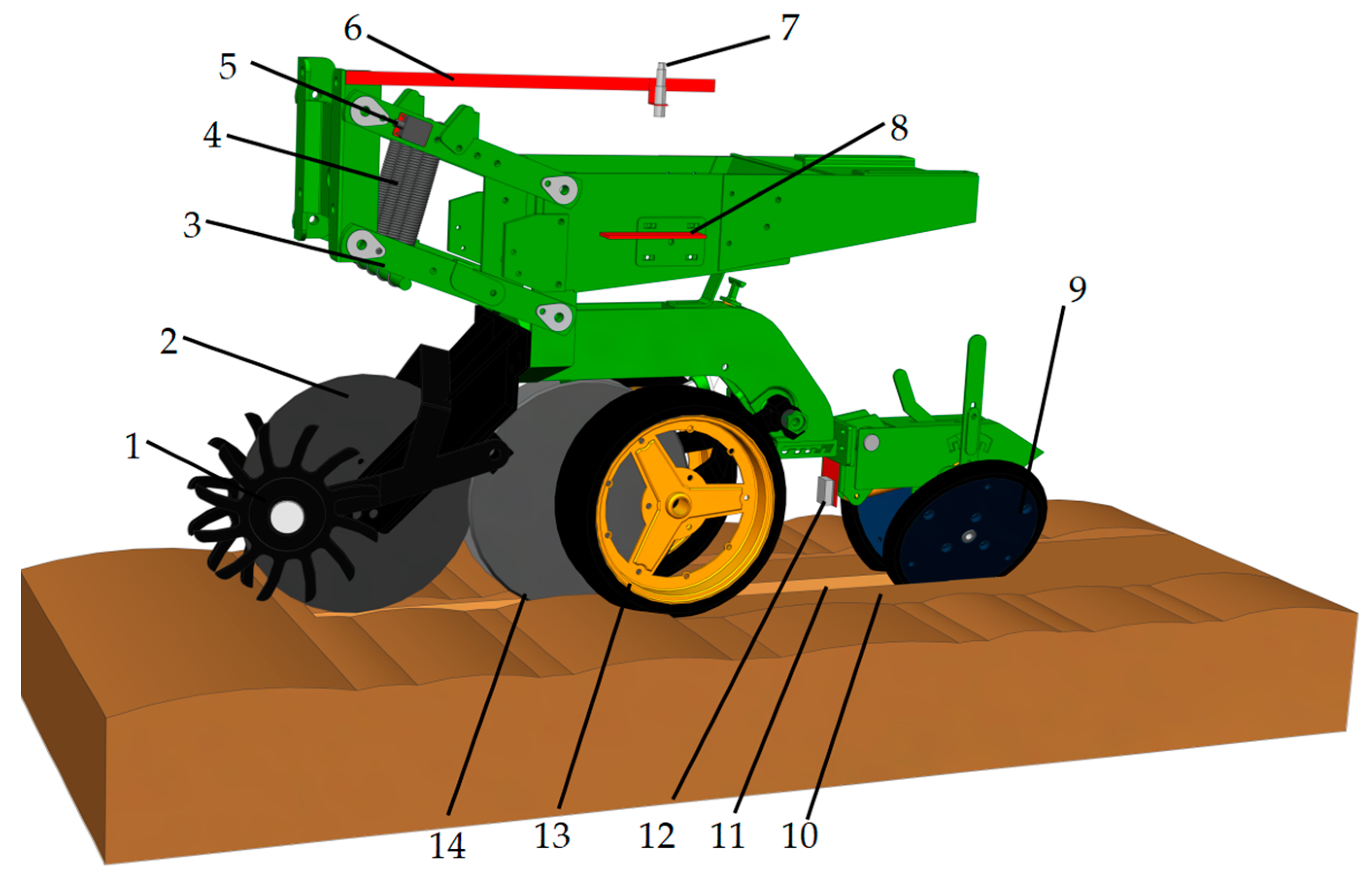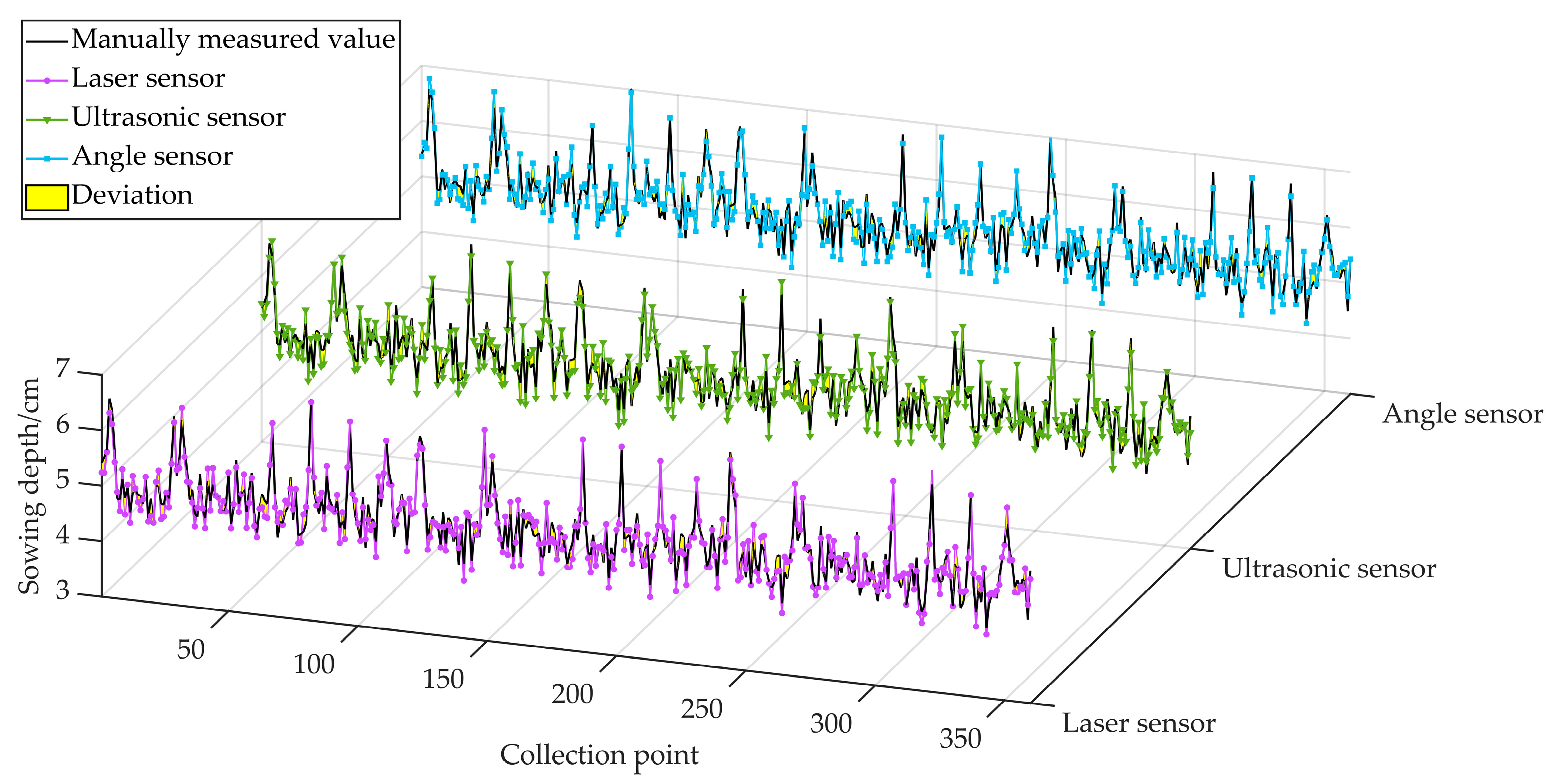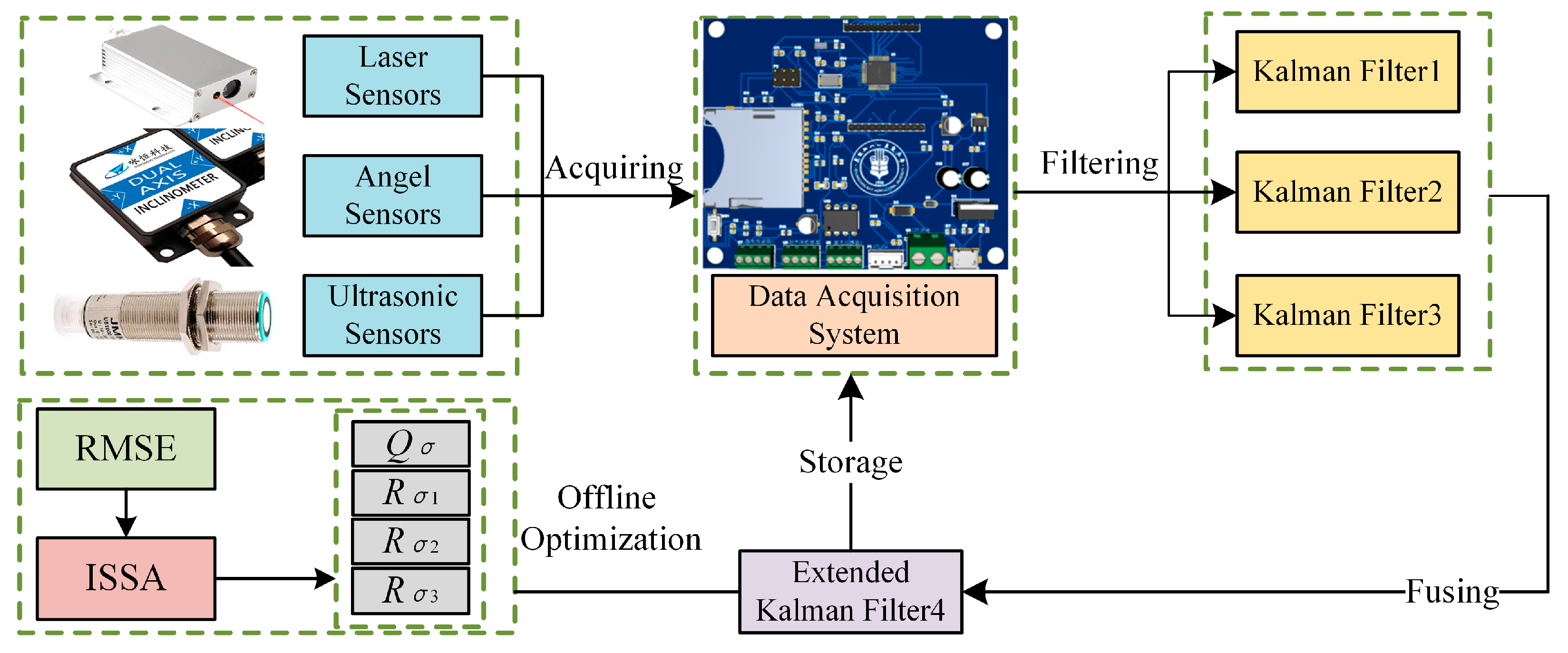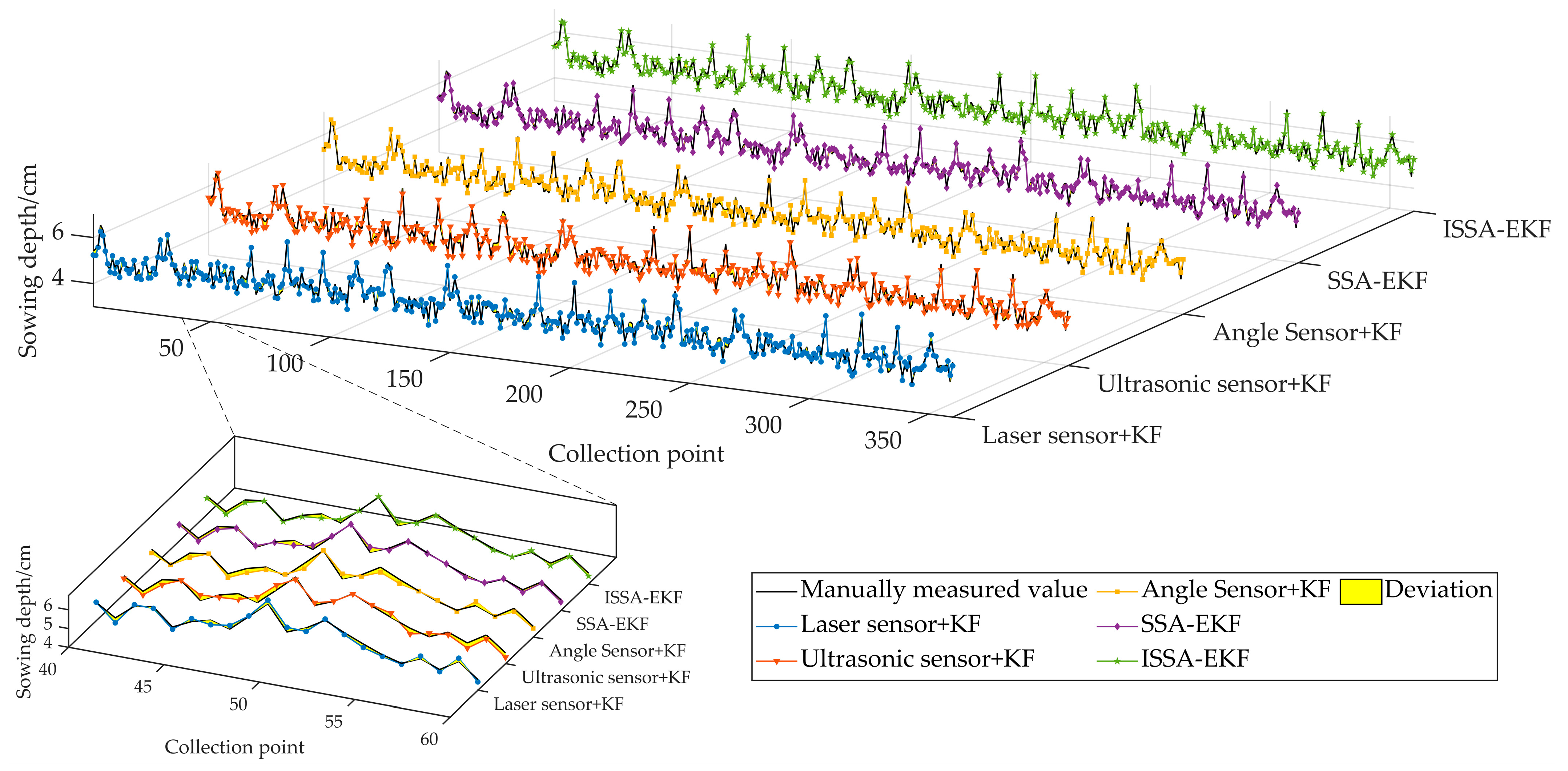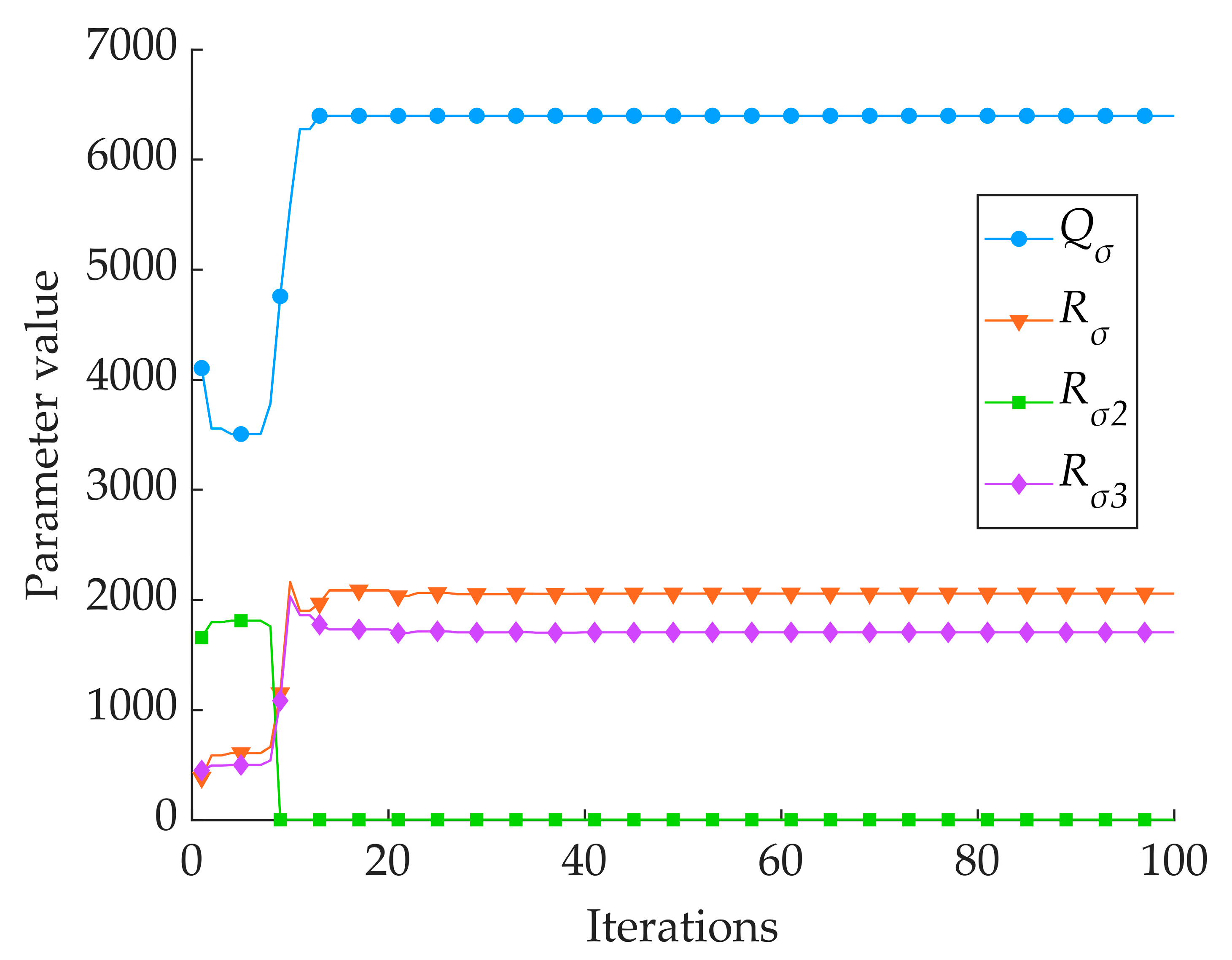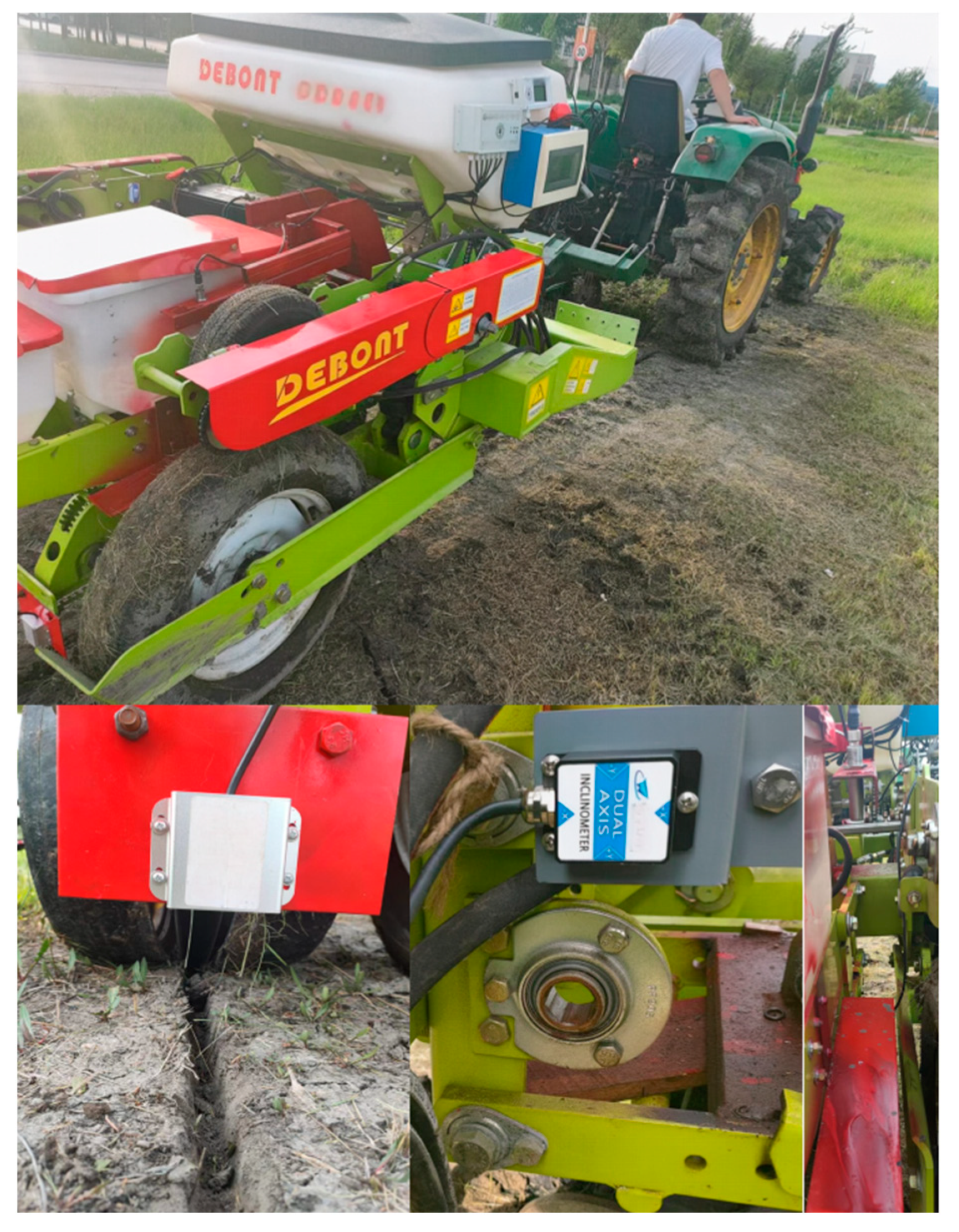2.1. Sowing Depth Monitoring Methods
In a no-tillage seeder in field operation, the sowing unit carries out the breaking of stubble, furrowing, sowing, and mulching compaction, comprising four links [
21]. Among them, the furrowing link is the process by which sowing depth is determined. Under the action of the seeder’s own gravity and the depth-limiting mechanism, the ground surface is placed at the bottom of the sowing unit disc furrow opener, and the theoretical depth of the fixed seed furrow is determined. A schematic of the sowing depth formation is shown in
Figure 1.
However, the field terrain is uneven, and high-speed operation under the conditions of single-body bouncing will lead to an inconsistent sowing depth. In this case, active compensation is needed, and a sowing depth monitoring value is needed for the active compensation system to feed back the sowing depth; thus, the monitoring of the reliability of the sowing depth directly affects the control accuracy of the active compensation system. The sowing machine selected for this study is the 1205-type high-speed no-tillage seeder produced by Beijing Debang Dawei Company. The disc opener of this planter and the sowing unit are relatively fixed at the same sowing depth position; however, due to the ground reaction force on the depth-limiting wheel, there is a height difference with the disc opener. Therefore, the actual sowing depth refers to the height difference between the bottom of the depth-limiting wheel and the bottom of the disc opener. The four links of the sowing unit swing on the axis of the fixed beam at the front end of the frame, and the upper and lower links always move in parallel. During operation, the four-rod profiling mechanism ensures that the sowing unit maintains up and down flat movements when working in the field so as to ensure the consistency of the sowing depth. In order to accurately measure the sowing unit sinking depth variable, a laser sensor, an ultrasonic sensor, and an angle sensor are selected to conduct simultaneous measurements. A schematic of the sowing depth monitoring sensor arrangement is shown in
Figure 2.
The three sensors of the research broadcast depth monitoring sensor group are the GJD-03 laser sensor (Ruixingjia Electronic, Shenzhen, China). in Guangdong Province, with a working voltage of 5~24 V DC; the UB1000-18GM75 ultrasonic sensor(Jiamei Science and Technology, Wenzhou, China) with a working voltage of 9~15 V DC; and the DYL626S angle sensor(Yongheng Science and Technology, Wuxi, China) with a working voltage of 10~30 V DC. The above sensors are Modbus sensors based on RS485 communication. The sowing depth monitoring system circuit is shown in
Figure 3. The sensors’ main parameters are shown in
Table 1. Diagrams of the detection principles of the sensors in the sowing depth detection system are shown in
Figure 4.
A laser sensor is installed between the disc opener and the suppression wheel, and the laser emission point of the sensor is installed parallel to the lowest point of the disc opener in order to ensure that it can measure the deepest part of the sowing furrow. When the sowing monobloc with the disc opener removed is placed in the soil, the distance between the laser emission probe and the compaction surface, as measured by the laser sensor, is 18.42 cm. Assuming that, during the no-tillage planter in-soil operation, the laser sensor measurement is
HL, the formula for the sowing depth
H is
A sensor-fixing platform is installed at the front end of the frame of the sowing unit, and the ultrasonic sensor probe installation position of this platform is parallel to the ground. Additionally, an ultrasonic reflective plate, which is horizontal to the ground, is installed at the side of the sowing unit, and the reflective plate is 20.43 cm away from the ultrasonic transmitting end of the sensor when the sowing unit with the disc opener removed is placed in the soil. Assuming that, during the operation of the no-tillage planter in the soil, the ultrasonic sensor measurement is
HU, the formula for the sowing depth
H is
With the parallel installation of an angle sensor on the four parallel links of the sowing unit, the centre distance between the two connection points of the four links is 40.0 cm. When the sowing unit with the unloaded disc opener is placed in the soil, there is a slight height difference between the four-link mechanism and the actual horizontal plane, and its actual height should be subtracted from the height difference. It can be seen that there is a difference of 1.55 cm, as measured by the sensor. Additionally, it is assumed that, in the case of no-tillage sowing machine operation in the soil, the operation swing angle is
α; therefore, the formula of the sowing depth
H is
In general, the noise interference contained in the acquisition signal of the laser sensors is due to the reflection and scattering of the laser beam [
22]. The noise interference contained in the acquisition signal of the ultrasonic sensors is due to the ambient noise and acoustic interference when the ultrasonic sensor receives the acoustic wave for echo measurement [
23]. The noise interference contained in the acquisition signal of the angle sensor is due to electromagnetic interference, including that from mechanical vibration, power lines, and high-frequency devices [
24]. Thus, the measurement accuracy is reduced. In conclusion, the laser, ultrasonic, and angle sensors are susceptible to mechanical interference, environmental noise, and measurement errors during the high-speed operation of the planter, which leads to a reduction in monitoring accuracy. In order to solve the above problems, multi-sensor fusion algorithms are widely used in multi-sensor monitoring systems with strong interference to reduce the effects of errors and noise on the sensor measurement results and improve measurement accuracy. The extended Kalman filter (EKF), which has the advantages of good real-time performance, robustness, high accuracy, and the ability to handle a large amount of data, has been widely used in sensor monitoring and other fields [
25,
26].
2.2. Sowing Depth Raw Data Collection
Sowing depth raw data were collected from 25 May to 29 May 2024 in the test field on the southeast side of Heilongjiang Bayi Agricultural University, Daqing City, Heilongjiang Province (125°166′~125°168′ E, 46°581′~46°584′ N). The test field was a no-tillage plot with unturned topsoil. In a pre-test plot, soil compaction was determined at 360 points equally spaced 2 m apart at 5 cm depths using a JC-JSD-01 soil compactness meter produced by Qingdao Juchuang Environmental Protection Group, Qingdao, China, and the average compactness was 7.1 kg/cm
2. The test was conducted using a John Deere 484 tractor (John Deere, Moline, IL, USA) towing a Deppon Dawei 1205 no-tillage planter (Deppon Dawei, Beijing, China) with an average operating speed of 12–16 km/h. The sowing depth data of 360 points were collected manually as the theoretical sowing depth values, as well as the original data to be filtered and fused with the sowing depth values in the simulation test. Due to the limitation of the length of the plot, it was necessary to repeat the test 10 times from the starting point of each operation, measuring the sowing depth value at an equal spacing of 2 m. Additionally, Hall sensors were arranged on the ground wheel of the planter so that when the ground wheel started to rotate, the three single sensors turned on to conduct synchronous measurements, and every time it travelled 2 m, the three single sensors conducted synchronous measurements once. A Tianmu XG-150 high-precision digital display depth gauge (Tianmu, Guilin, China) was used to measure the number of collection points output by the system after each test. The sowing depth values of the first and last five points in the 10 tests were from the acceleration and deceleration phases of the tractor, so the middle points of the 10 tests, totalling 360 effective collection points, were used as the original data for the theoretical measurement value in the simulation test, and the sowing depth data obtained from the three single sensors in each test were used for the same operation. To compare the actual monitoring effect of the three single sensors, this study selected three key performance assessment indices: the mean absolute error (
MAE), the root mean square error (
RMSE), and the correlation coefficient (
R). The
MAE and
RMSE were used to assess the accuracy of the sensor monitoring values, and the
R was used to assess the reliability of the sensor monitoring values in order to verify the validity of the multi-sensor method of measuring sowing depth. A comparison of the performance evaluation indicators between the measured values and the sensors’ real values is shown in
Table 2, and comparison graphs of the three single sensors’ measured values and the manually measured values are shown in
Figure 5.
In
Table 1 and
Figure 5, it can be seen that the three sensors perform relatively well in terms of the
MAE,
RMSE, and
R key performance indicators. This means that the differences between the three measurements and the real values are small, with high consistency and stability. Therefore, the measurements of the three sensors can be considered reliable and suitable for subsequent filtering and data fusion operations.
2.3. EKF Multi-Sensor Fusion Algorithm
The Kalman filter reduces the effects of noise and errors on data through a feedback mechanism; however, its performance is affected by the linear nature of the system and noise. A system or measurement model with a nonlinear component may not be able to handle the problem with a Kalman filter. However, the EKF, a Kalman filter algorithm based on nonlinear systems [
27], can transform the nonlinear component of the system into a linear component through linearisation and updating the observation and state transition equations. In data fusion, the Kalman filter results from multiple sensors can be fused to estimate the system state using their corresponding metric models to obtain a more accurate and reliable sowing depth.
For complex scenarios such as sowing operations, efficient filtering and algorithm fusion are required to eliminate noise interference and improve the estimation accuracy and tracking capability of the target state. The signals collected from the laser, ultrasonic, and angle sensors are processed using Kalman filtering, and then the filtered data are fused using the EKF to obtain more accurate and reliable sowing depth values. The EKF has higher accuracy when applied to a sowing depth measurement system in this environment; it can handle the problem of a large amount of data and has scalability. Furthermore, for the processing of complex sensor data, the EKF can improve the sensor tracking capabilities.
The state and measurement equations are mathematical equations used to describe the EKF dynamic system and the observation process. The state quantity is the sowing depth estimate, and the observation quantity is the sowing depth measurement obtained using multiple sensors. The state quantity
x is defined as the sowing depth estimate, and the state transfer function is defined according to the physical model and system dynamics. For the state transfer equation, the sowing depth can be considered a first-order lagging system with the state equation of
where
xk is the sowing depth state vector at moment
k;
xk−1 is the sowing depth state vector at moment
k − 1; and
wk is the system process noise at time
k, which obeys Gaussian noise with a mean of 0 and covariance
Q.The EKF measurement equation is obtained from the previous sowing depth measurement equation for the three single sensors’ measurements:
where
zk is the observation vector at moment
k, and
vk is the measurement noise at moment
k.This, in turn, leads to the EKF-based sowing depth monitoring equation:
where
is the priori estimate of the sowing depth at moment
k, cm;
is the
k − 1 posteriori estimate of the sowing depth at moment
k − 1, cm;
is the priori covariance matrix at moment
k;
is the vector
k − 1 moment a posteriori covariance matrix; and
Qk is the monitoring state Gaussian noise
k moment covariance matrix.
As the monitoring model of the angle sensor is nonlinear, it must be linearised; thus, the EKF linearisation, measurement, and monitoring equations are
where
Hk is the measurement matrix, and
is the sensor observation variables at moment
k.
The EKF update allows the sowing depth data monitored during the fusion process to be fused with the system model to obtain a more accurate estimate of the state, and the updated EKF equation is
where
K is the Kalman gain;
is the transpose matrix of the measurement matrix; and
Rk is the Gaussian noise
k moment covariance array of the measured values.
The EKF can estimate the sowing depth using the above operations, and the trade-offs in determining the Q and R values need to be adjusted according to specific application scenarios and system characteristics. In general, the system noise covariance matrix (Q) reflects the uncertainty in the model of the sowing depth measurement system, and the measurement noise covariance matrix (R) reflects the measurement uncertainty of the three single sensors. When Q is set too large, it leads to an overdependence of the filter on the model and, thus, insensitivity to changes in the measurements, which may result in a slower filter response. Conversely, when Q is set too small, the filter becomes overly dependent on the measurements and may be disturbed by measurement noise, leading to unstable results. Therefore, when selecting Q, a balance between the model and the measurement is required, and when selecting R and Q, they need to be rationally adjusted according to the actual measurement error.
2.4. Improved Sparrow Search Algorithm
The
R matrix and
Q matrix parameter rectification of the EKF is actually a parameter optimisation problem, and the use of the intelligent swarm optimisation algorithm is an efficient way to solve it. The SSA is a new type of swarm intelligent optimisation algorithm; it searches the solution space of the optimisation problem through a simulation of the sparrow population behavioural strategy, and it simulates the life behaviour of the sparrow population to search for the optimum [
28]. Compared with other algorithms, in optimising the EKF problem, the SSA increases the diversity of the search by moving and communicating between individuals, thus having the ability to perform a global search and avoid falling into a local optimum. Secondly, the SSA has parallelism and distributed computation abilities, which can search multiple candidate solutions in
R and
Q matrices at the same time. The SSA also has adaptability and robustness, and it can be better adapted to different optimisation problems. In addition, the SSA is scalable and applicable to various optimisation scenarios, such as parametric, functional, and combinatorial optimisation. The principle of multi-sensor data fusion in the sowing depth monitoring system is shown in
Figure 6.
In the SSA, the explorer is responsible for exploring new potential solutions and ensuring the global search capability of the algorithm. The position update equation of the explorers is
where
Xi is the position of the
i-th sparrow,
t is the current number of iterations,
β is the control parameter,
R2 is a random number between [0, 1],
ST is the safety threshold, and
ξ is the Gaussian distributed random number.
The followers in the SSA enhance the local search by following the optimal solution to improve the convergence speed of the algorithm, and the position update equation of the followers is
where
n is the total number of sparrows.
The scouts in the SSA, however, participate in the search process while maintaining the security of the group, which increases the diversity and robustness of the algorithm. The position update equation of the scouts is
where
Xbest is the location of the current optimal solution.
Although the SSA has many technical advantages in the parameter rectification problem of the
R and
Q matrices of EKF filters, it also has some disadvantages, such as initialisation parameter setting and cross-selection assignment problems. Therefore, this study improves the SSA by introducing the chaotic mapping algorithm [
29] to adjust the initialisation process of the SSA. The aim of the initialisation formula is to determine the initial position of an individual in each dimension by mapping the result of the chaotic mapping to the position of a sparrow. Chaotic mapping is extremely sensitive to the initial conditions, and even small differences in the initial values can lead to completely different iteration sequences. This property allows chaotic mapping to produce diverse search paths in optimisation algorithms, helping to prevent the algorithm from falling into local optima. Using ICMIC chaotic mapping,
where
zn is the chaos variable.
Meanwhile, the Gaussian random walk algorithm [
30] is used to optimise cross-selection allocation. Gaussian random walk can strike a balance between exploring new regions and exploiting known information by controlling the size of the standard deviation. A small standard deviation facilitates local search, while a large standard deviation promotes global search. Gaussian random walk allows for fine-grained exploration in the vicinity of the current solution, which helps the SSA to search deeper in the vicinity of the local optimum, thus increasing the probability of finding a better solution. The randomness provided by Gaussian random walk helps the algorithm to resist the effects of noise and outliers, and it improves the robustness of the algorithm. The Gaussian random walk formula introduced in the crossover process is given as
where
σ is the standard deviation of the Gaussian random walk, and
ε is the Gaussian distributed random number.
In this way, chaotic mapping and Gaussian random walk are integrated into the SSA to improve its search performance and ability to solve complex optimisation problems.
2.5. ISSA-EKF
This study selected the
RMSE as the fitness function for the optimisation of the algorithm; the selection of the
RMSE as the fitness function can help the ISSA to find a more desirable solution in the optimisation of the EKF problem in order to improve the accuracy and reliability of the model for sowing depth monitoring.
where
fitness is the fitness function;
si is the actual sowing depth, cm;
wi is the estimated sowing depth, cm; and
n is the sampling time.
According to the previous analysis, the ISSA optimises the parameters of the
Q and
R matrices in the EKF, where the covariance matrix
Q of process noise is a one-dimensional matrix, and the covariance matrix
R of measurement noise is a three-dimensional matrix; thus, it optimises a total of four parameters, namely,
Qσ in the
Q matrix and
Rσ1,
Rσ2, and
Rσ3 in the
R matrix. The ISSA-EKF has five operational steps: the initialisation of the optimisation environment, crossing behaviour, population update, termination conditions, and output results. Through these steps, the optimisation of the parameters of the
Q and
R matrices in the EKF by the ISSA can be achieved to improve the accuracy and reliability of the model monitoring. A flowchart of the ISSA-EKF is shown in
Figure 7.

